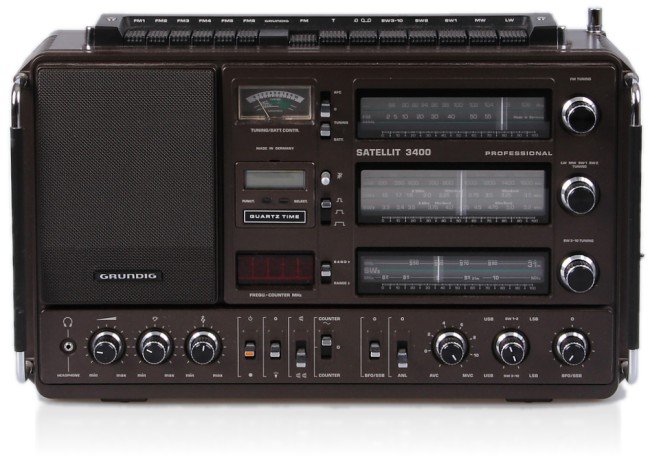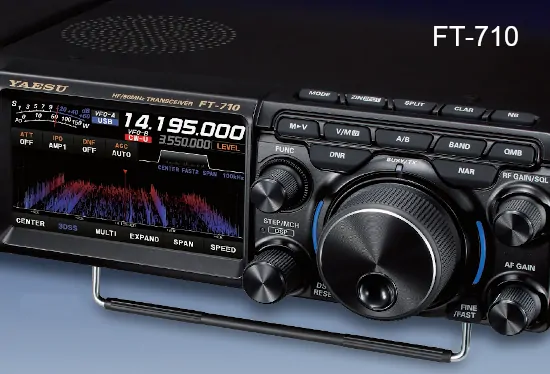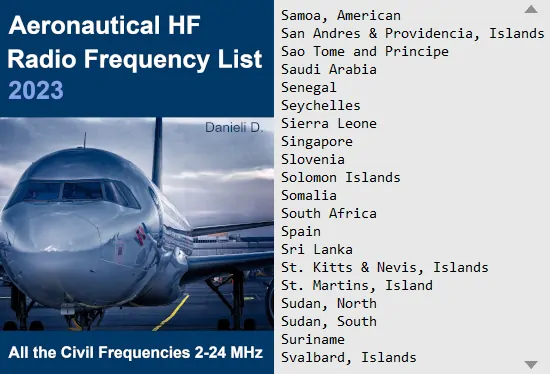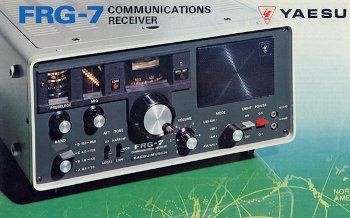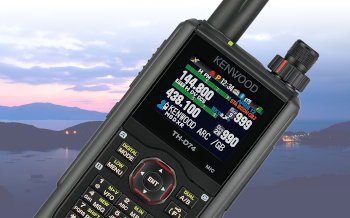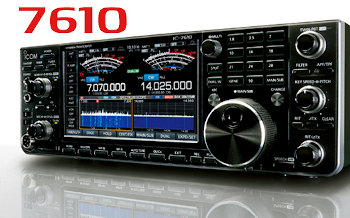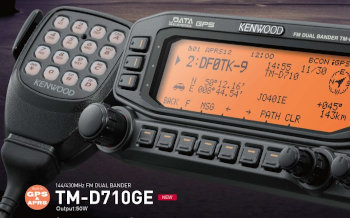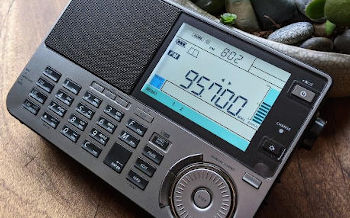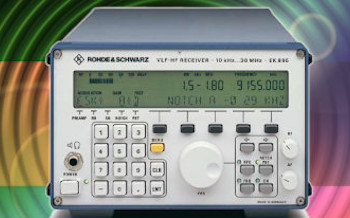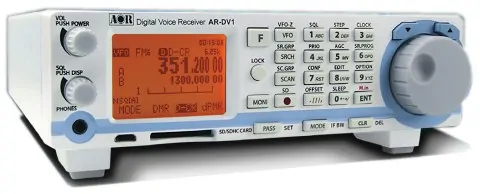
Wide-band SDR receiver, 0.1-1300 MHz coverage with no interruptions, all-mode including digital voice standards. The first software defined receiver of its kind in AOR production. Ideated in Japan, year of introduction 2015.
Reference market : amateur-radio
AR-DV1 specifications
| General |
| Frequency coverage | |
|---|---|
| 0.1000 ~ 1300.0000 MHz [1] | |
| Mode | |
| CW / SSB / AM / AM-S / FM / WFM / P25 / dPMR / DMR / TETRA [4] / NXDN, Digital-CR / D-Star / Alinco / Yaesu | |
| Tuning step | |
| 10 / 50 / 100 / 500Hz / 1 / 2 / 5 / 6.25 / 7.5 / 8.33 / 9 / 10 / 12.5 / 15 / 20 / 25 / 30 / 50 / 100 / 500 KHz |
| Receiver |
| Sensitivity [2] | |
|---|---|
| FM | 0.71 uV (0.53~18 MHz, 12dB SINAD)
0.32 uV (18~1300 MHz, 12dB SINAD) |
| Selectivity | |
| CW | 0.2 / 0.5 KHz (-3dB) |
| SSB | 1.8 / 2.6 KHz (-3dB) |
| AM | 3.8 / 5.5 / 6 / 8 KHz (-3dB) |
| AM-S | 3.8 / 5.5 (-3dB) |
| FM | 6 / 15 / 30 KHz (-3dB) |
| WFM | 100 / 200 KHz (-3dB) |
| AGC (Automatic Gain Control) | |
| Adjustable | |
| Frequency stability | |
| ± 2.5ppm with temperature from 0°C to +50°C after 5' warm-up | |
| IF (Intermediate Frequency) [3] | |
| 1° | 393 MHz (18~180 MHz)
1705 MHz (180~1300 MHz) |
| 2° | 31 MHz (18~180 MHz)
393 MHz (180~1300 MHz) |
| 3° | 31 MHz (180~1300 MHz) |
| Features |
| Memory | |
|---|---|
| 2000 regular memories in 40 banks
3 VFO |
|
| Display | |
| LCD | |
| Antenna | |
| BNC 50Ω | |
| Power supply | |
| 10.8 ~ 16 VDC external, 12 V nominal | |
| Power consumption | |
| 750 mA | |
| Audio power | |
| 1 W on 8Ω | |
| Audio output | |
| Jack 3.5 mm headphone
Jack 3.5 mm external speaker Jack 3.5 mm FM discriminator |
|
| Connections | |
| Micro-USB |
| Mechanical and environmental data |
| Operating temperature | |
|---|---|
| from 0°C to +50°C | |
| Dimensions | |
| 178 (W) x 50 (H) x 215 (D) mm | |
| Weight | |
| 1.5kg |
- Specifications not guaranteed in 0.1~0.53 MHz range, cellular blocked in the US.
- Values not referenced to specific bandwidth.
- Direct sampling architecture in 0.1~18 MHz range, without IF conversions.
- TETRA mode was added in the AR-DV1 production after a certain date.
The AOR AR-DV1 is among the first receiver to offer a variety of digital formats demodulation in the hobby equipment, in addition to the usual analogue modes such as SSB, AM and FM. It is therefore a product that makes listening potential in areas that were previously not very accessible, a decisive advance step. On the technological side this AOR uses a conventional frequency conversion (super-heterodyne) structure when the interval between 18~1300 MHz is tuned while it is direct-conversion (SDR) for the range between 100 KHz and 18 MHz. Specifically for emissions on VLF and HF bands, the AR-DV1 integrates signal processing functions thanks to which it is possible to optimize the monitoring of a spectrum typically conditioned by interference and fading. Among these functions the auto-notch, the filter that automatically detects and attenuates the discrete components present in the audio, and the adaptive noise-reduction (NR) for the AM and SSB modes. Another control that becomes appreciable when listening below 30 MHz concerns the AGC which can be set to act with slow, medium or fast time constant as well as manually adjusted by the RF-gain command. Synchronous demodulation (AM-S), with selection of the lower side band (SAL) or higher side band (SAH), is available to improve the fruition of AM broadcasting stations.
Remarkable capabilities for the VHF / UHF segment, among them to remain in analogue modes: audio band reversal voice-descrambler set between 2000~7000 Hz in steps of 10 Hz. Squelch that can be adjusted to the noise threshold, on a certain signal level, on the presence of audio, or even unlocked in presence of specific tones in the DCS (Digital Coded Squelch) and CTSS (Continuous Tone Controlled Squelch System) standards. Setting an offset to quickly tune in / out the radio-repeater. Multiple, and complete, tuning steps including the 8.333 KHz step used in the aeronautical band. Medium frequency bandwidths (IF) suitable for all conditions including 30 KHz useful for receiving SAT weather signals on VHF. Audio output directly from the FM discriminator for the acquisition of data flows.
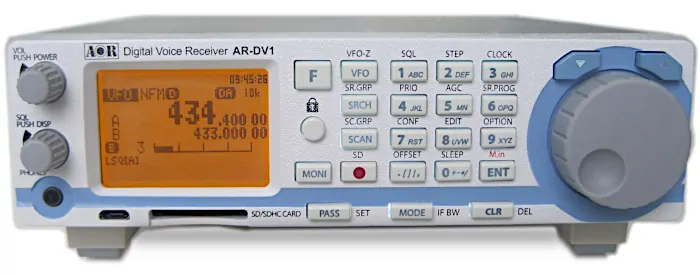
AOR AR-DV1 scanner, front panel photo
The AOR has developed the AR DV1 thinking to digital standards that are consolidating in radio communications. In this context, the receiver offers the decoding of the major systems used in ham-radio and in the private / professional PMR sectors. The table below shows the different operating modes and associated variants supported:
| ALINCO DIGITAL (EJ-47) | |
|---|---|
| Mode variant | Voice mode |
| Encoding | --- |
| Compatible vocoder | AMBE |
| DIGITAL-CR | |
| Mode variant | --- |
| Encoding | Non encrypted |
| Compatible vocoder | AMBE+2 |
| DMR | |
| Mode variant | TIER 1 and TIER 2 |
| Encoding | Non encrypted |
| Compatible vocoder | AMBE+2 |
| dPMR | |
| Mode variant | dPMR446 and TIER 1 |
| Encoding | --- |
| Compatible vocoder | AMBE+2 |
| D-STAR | |
| Mode variant | --- |
| Encoding | --- |
| Compatible vocoder | AMBE |
| NXDN | |
| Mode variant | Regular mode |
| Encoding | Non encrypted or scrambling (15 Bit) |
| Compatible vocoder | AMBE+2 |
| P25 | |
| Mode variant | PHASE 1 |
| Encoding | Non encrypted |
| Compatible vocoder | IMBE |
| TETRA | |
| Mode variant | Mobile-mobile |
| Encoding | Non encrypted |
| Compatible vocoder | --- |
| YAESU DIGITAL | |
| Mode variant | V/D mode |
| Encoding | --- |
| Compatible vocoder | AMBE+2 |
It should be noted that these modes concern communications encoded in digital data streams but transmitted without the intervention of speech encryption algorithms which would naturally require dedicated decoding keys. Other general functions: digital audio recorder in WAV format based on SD / SDHC card with a typical 7 hours duration for 1 GB. Timer for alarm and unattended recording, auto-off timer at 30, 60, 90, 120 minutes. USB interface for PC control and internal firmware update. Various scanning functions between frequencies, memories, priority channel. Memory banks with 2000 locations, possibility to identify each one with a text up to 12 characters.
AR-DV1 performance and practical notes :
AR-DV1 concentrates in itself many functions. It should be clarified that the main vocation is to refer to the advanced scanner that places in the hands of the user a versatile receiver and at the same time able to deal with the bounds of radio. The field of play therefore sees in the foreground the VHF and the UHF, just in this scenario it is worth mentioning a couple of aspects as examples of the project philosophy. On the one hand, a frequency conversion scheme that sees a 1st IF at 1.7 GHz with the intent, substantially successful, of minimizing the problems due to the image frequencies - an element that certainly has a negative impact on many other scanner models. On the other hand, finally opening the doors to the monitoring of free digital communications, the compatibility with the dPMR-446 standard or the counterpart of the popular 446 MHz analogue PMRs is a tangible proof. On the side of the long, medium and short waves, the considerations are necessarily directed on a different plane. The performances are still noticeable thanks to the possibility of selecting between different bandwidths for each modulation class - to mention one of the relevant features - but the many functions (AGC, notch, NR, IF) concentrated on a limited set of buttons / knobs make the ergonomics not ideal.
AR-DV1 IF bandwidth :
The IF bandwidth determines how selective the receiver will be when monitoring signals. However, it is not simply a case of using the narrowest filter at all times, particular modes require differing amounts of bandwidth in order to operate. Otherwise the receive system will not produce intelligible sound. Correct receive mode and IF bandwidth must always be selected for optimum reception. If the bandwidth selection is too narrow, distortion or signal break-up may occur. If the bandwidth selection is too wide, adjacent interference may be encountered. For this reason, a selection of IF filter bandwidths are provided as standard. Typical examples of receive mode and IF bandwidth are:
| Bandwidth / Applications | |
|---|---|
| ~200 kHz | FM 87.5-108 MHz broadcast. |
| ~100 kHz | Wireless microphone. |
| ~30 kHz | Wireless microphone, satellite WEFAX. |
| ~15 kHz | PMR, amateur band, etc. |
| ~6 kHz | Short wave broadcast, medium & long wave broadcast, VHF/UHF airband, PMR, etc. |
| ~3 kHz | Short wave SSB amateur communications, short wave utility, etc. |
| ~0.5 kHz | Morse code used by radio amateurs and some utility on short wave. |
An appropriate IF filter is automatically selected when auto mode is selected. However any combination of IF filter and receive mode is possible in the manual mode. When you have manually selected an IF filter bandwidth, auto mode will be cancelled, but the receive mode, frequency step, etc., will be retained until they are changed manually. Manually selecting IF bandwidth: Press the [F] key and then the [MODE] key. Select a new bandwidth from the list by rotating the dial knob. To accept the new bandwidth selection, press the [ENT] key. Note: The IF bandwidth will be selected automatically in all digital modes. Selectable bandwidth as follow.
| Mode / Selectable bandwidth | |
|---|---|
| FM | 200, 100, 30, 15, 6 kHz |
| AM | 15, 8, 5.5, 3.8 kHz |
| SAH / SAL | 5.5, 3.8 kHz |
| USB / LSB | 2.6, 1.8 kHz |
| CW | 0.5, 0.2 kHz |
Note: SAH/SAL (Upper Side Band/Lower Side Band) selectable synchronous detection.
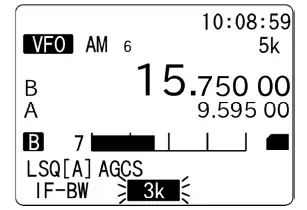
AOR AR-DV1 display, example of IF bandwidth
AGC is available for AM, SAH, SAL, USB, LSB and CW mode. To change the AGC parameter setting, press the [F] key and then the [5] key. Select a new AGC parameter from the list of "AGCF" (fast), "AGCM" (middle), "AGCS" (slow), by rotating the dial knob. To accept the new AGC parameter, press the [ENT] key. Usually, FAST is used to receive CW, MEDIUM for AM and FM, and SLOW for SSB mode. However, this option cannot be configured in FM mode. When AGC is set to RF-G, the RF gain control can be adjusted by the squelch knob.
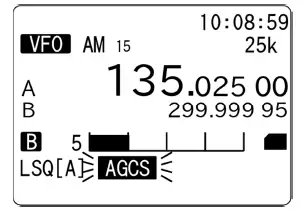
AOR AR-DV1 display, example of AGC parameter
AR-DV1 memory system :
The receiver has 2000 memory channels and one priority channel. Each memory channel may hold:
- One receive frequency.
- Receive mode.
- Tuning step.
- Text comment up to 12 characters.
The alphanumeric comment may be used to ease identification at a later date. The 2000 memory channels are divided into 40 banks, and each bank has 50 channels. The memory banks are identified by the first BANK number 0, 1, 2, 3, ..., 48, 49 and the individual channels are numbered from 00 to 49. Example: 1234 is the memory bank 12 and memory channel 34. The data contents of memory and search banks are held in an EEPROM so that no backup battery is required for memory retention. Note: When the receiver is switched OFF, all VFO data will be automatically stored into EEPROM memory storage.
AR-DV1 voice descrambler :
Analog voice descrambler (SCR) is used to decode scrambled analog voice transmission by frequency inversion. Note: This function operates only in FM mode with less than 30 kHz of IF bandwidth and is not available for US consumer version. To activate the function press the [F] key and then the [1] key. Press the [˅] key to select "SQL" parameter in reverse contrast. Now rotate the dial knob to select "SCR" in reverse contrast. Press the [˅] key to select "V.SCR" parameter in reverse contrast. Rotate the dial knob to select the inversion frequency from the range of 2000 Hz ~ 7000 Hz in 10 Hz steps (default 2000 Hz). Once properly selected, the decoded voice becomes intelligible. Press the [ENT] key to accept the entry and return to a standard display. Alternatively, press the [CLR] key to abort entry.
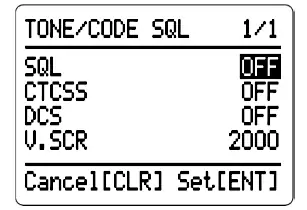
AOR AR-DV1 display, example of voice descrambler parameter
AR-DV1 frequency step and step adjust :
To select frequency step press the [F] key and then the [2] key. Rotate the dial knob to select one of the following preset frequency steps: 0.01 kHz (10Hz), 0.05 kHz (50Hz), 0.1 kHz (100Hz), 0.5 kHz (500Hz), 1 kHz, 2 kHz, 5 kHz, 6.25 kHz, 7.5 kHz, 8.33 kHz, 9 kHz, 10 kHz, 12.5 kHz, 15 kHz, 20 kHz, 25 kHz, 30 kHz, 50 kHz, 100 kHz, 500 kHz. Press the [ENT] key to confirm entry or press the [CLR] key to abort entry.
Step adjust function is used when the receiving frequency is not divisible by the current step size to follow unusual band plans. For example:
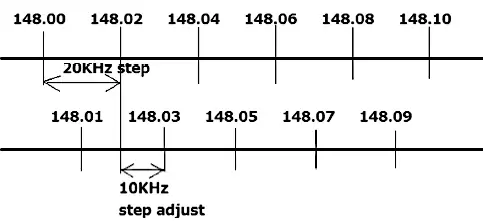
20 kHz channels frequency separation with unusual 10 kHz offset
To activate the step adjust function press the [F] key and then the [2] key. Now press the [PASS] key. Rotate the dial knob to select the preset step adjust frequency. For example:
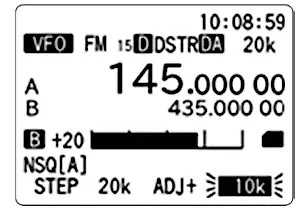
AOR AR-DV1 display, example of step adjust input
In above example frequency setting, a half of the current frequency step (i.e. 10 kHz) will be initially selected. Note that the step adjust can be selected only less than a half of current frequency. Note: The step frequency must be higher than 0.1kHz to use this function. Press the [ENT] key to confirm entry or press the [CLR] key to abort entry.
AR-DV1 frequency offset adjust :
The frequency offset function enables receive frequency to be shifted by preprogrammed value. This function helps quickly to track duplex transmissions or check repeater inputs/outputs. Some offset frequencies have been preprogrammed by the factory. Frequency offset may also be programmed manually by the user. The locations for frequency offset storage are numbered 20~39 and cannot be changed by the user. Locations 01~19 may be programmed by the user.
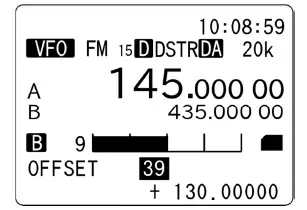
AOR AR-DV1 display, example of frequency offset function
To configure the frequency offset press the [F] key and then the [.] key. Now the frequency offset screen will appear. Rotate the dial knob to select the offset channel as follow:
| Channels / Status | |
|---|---|
| 00 | Cannot be changed |
| 01 ~ 19 | User programmable |
| 20 ~ 39 | Preprogrammed by factory, cannot be changed |
To change the user programmable channel, enter the offset frequency from the numeric keypad. To change the shift direction, press the [PASS] key to toggle between "+" and "-". To confirm entry, press the [ENT] key. Alternatively, press the [CLR] key to cancel entry.
AR-DV1 price
We have collected for your convenience the Aor AR-DV1 sale price (US Dollar) and its trend over time. Useful to guarantee a cheaper purchase of this radio and to put it for sale in the second-hand market. Of course offers, accessories, warranty terms and conditions can lead to different figures.
|
|
|
|
| USD 1434.95 | 2023-mar | Brand-new |
|
USD 1529.00 (1299EUR) |
2021-jun | Brand-new |
| USD 1199.95 | 2018-oct | Brand-new |
AR-DV1 review
| Sensitivity | |
| Selectivity | |
| Dynamic range | |
| Spurious response | |
| Audio | |
| Signal functions | |
| Control functions | |
| User friendly | |
| Stars: 1=insufficient | 2=just sufficient | 3=mediocre | 4=good | 5=excellent | |
| Collmax | July-21 2021 |
I bought the DV1 in 2019, I downloaded the free updates from the AOR website and I can say that it works very well in all modes and in all its functions. Great buy.
[End post]
| magicdolphin |
In my view, the project enclosed in such a small box came out badly. I scanned all the VHF and UHF frequencies to listen to digital signals and in addition to Amateur-radio QSO I was unable to decode anything else. The purchase of the key for the TETRA did not prove useful either. Yet in Rome there are really many signals. The micro-USB socket never worked! They did me the favor of repairing it under warranty. I will no longer connect it to the PC also because I do not see what it can be useful for! Bad buy!
[End post]
Your opinion on merits, defects, experiences, with this radio set is welcome. Write your review, after a technical evaluation by our staff if found suitable will be published on this page. We thank you for your precious contribution.
